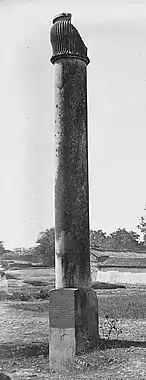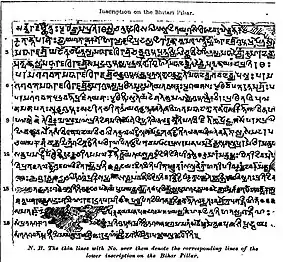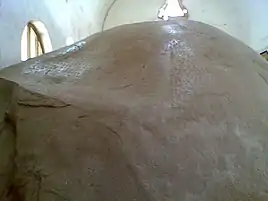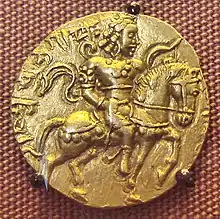| Skandagupta | |
|---|---|
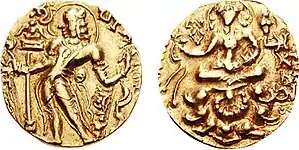 Gold coin of Skandagupta, depicting himself on the obverse, Lakshmi on the reverse. The name | |
| 8th Gupta Emperor | |
| Reign | c. 455 – c. 467 CE |
| Predecessor | Kumaragupta I |
| Successor | Purugupta |
| Dynasty | Gupta |
| Father | Kumaragupta I |
| Religion | Hinduism[1] |
Skandagupta (Gupta script: ![]()
![]()
![]()
![]() Ska-nda-gu-pta,[2] r. c. 455-467) was a Gupta Emperor of India. His Bhitari pillar inscription suggests that he restored the Gupta power by defeating his enemies, who may have been rebels or foreign invaders. He repulsed an invasion by the Indo-Hephthalites (known as Hunas in India), probably the Kidarites. He seems to have maintained control of his inherited territory, and is generally considered the last of the great Gupta Emperors. The Gupta genealogy after him is unclear, but he was most probably succeeded by Purugupta, who appears to have been his younger half-brother.
Ska-nda-gu-pta,[2] r. c. 455-467) was a Gupta Emperor of India. His Bhitari pillar inscription suggests that he restored the Gupta power by defeating his enemies, who may have been rebels or foreign invaders. He repulsed an invasion by the Indo-Hephthalites (known as Hunas in India), probably the Kidarites. He seems to have maintained control of his inherited territory, and is generally considered the last of the great Gupta Emperors. The Gupta genealogy after him is unclear, but he was most probably succeeded by Purugupta, who appears to have been his younger half-brother.
Early life
Skandagupta was a son of the Gupta emperor Kumaragupta I.[3] His mother may have been a junior queen or a concubine of Kumaragupta. This theory is based on the fact that Skandagputa's inscriptions mention the name of his father, but not of his mother.[4] For example, Skandagupta's Bhitari pillar inscription lists the chief queens (mahadevis) of his ancestors Chandragupta I, Samudragupta, and Chandragupta II, but does not mention the chief queen of his father Kumaragupta.[5][6] J. F. Fleet read a line of the Bhitari inscription to state that Skandagupta was "raised to Aryan status by the panegyrics of bards". Based on this, A. L. Basham theorized that his mother was from a low-caste Shudra background.[7]
Others, such as Dasharatha Sharma have criticized this theory, pointing out that the Bhitari inscription clearly suggests that Skandagupta's mother held a very exalted status in the eyes of her son.[7] The inscription states that after restoring the fallen fortunes of his family by defeating his enemies, he visited his mother just like the legendary hero Krishna had visited his mother Devaki.[3] Jagannath Agrawal theorizes that the composer of the inscription deliberately departed from convention and devoted a line to the king's mother: this was not because of the inferior status of the mother.[8] Agrawal disputes Fleet's reading of the "Aryan status" line, providing an alternative reading: "whom nobility causes to blush by reason of the narrations of his exploits by means of songs and eulogies". This line seems to be inspired from a verse in Kalidasa's Raghuvaṃśa. Agrawal further argues that the Bhitari inscription is a prashasti aimed at glorifying the king, and its composer would not have made a derogatory insinuation about the low status of the king's mother.[8]
Based on the inscription, some scholars have theorised that Devaki was the name of his mother. However, according to historian R. C. Majumdar, it is more likely that the description aims to highlight the degraded position of his mother just like that of the legendary Devaki, before Skandagupta restored her to a position of prestige and power, just like Krishna did for Devaki.[3]
Ascension to the throne
Skandagupta ascended the throne in year 136 of the Gupta era (c. 455-456 CE).[3] According to the Bhitari pillar inscription, he restored "the fallen fortunes of his family". The inscription states that when he prepared to do so, he spent a night on the bare earth, and then defeated his enemies, who had grown wealthy and powerful. After defeating his enemies, he visited his widowed mother, whose eyes were "full of tears from joy".[3]
Many scholars read the name of the enemies mentioned in the Bhitari inscription as "Pushyamitras", who according to the Puranas, were a tribe, and probably ruled an area located on the banks of the Narmada River. However, an alternative interpretation of the inscription reads "Yudhyamitras" (a generic term for enemies) instead of "Pushyamitras".[9]
According to one theory, these enemies invaded the Gupta empire during the last years of Kumaragupta's reign, or shortly after his death, and Skandagupta defeated them. According to another theory, the conflict referred to in the Bhitari inscription resulted from a disputed succession to the throne. This theory is based on the following points:[9]
- The Junagadh inscription states that after his father's death, Skandagupta became "the ruler of the earth" by his own prowess.[9] This suggests that Skandagupta acquired the throne using force.[5]
- His mother may was probably a junior wife of Kumaragupta rather than the chief queen (see Early life section above), and therefore, his claim to the throne was not legitimate.[5][6]
- The Junagadh inscription states that Lakshmi, the goddess of fortune, chose Skandagupta as her husband after rejecting all other "sons of kings".[11][9] Some coins issued by Skandagupta depict a woman offering him an uncertain object, probably a garland or a ring. Assuming this woman is Lakshmi, the depiction seems to be a visual representation of the statement made in the inscription.[12] (Some scholars identify the woman as a queen rather than Lakshmi).[11]
- The Bhitari inscription makes three mentions of the fallen fortunes of the Gupta family (kula or vamsha). The mention of family, rather than the empire, may be a reference to the disputed succession to the throne. The reading "Yudhyamitras", rather than "Pushyamitras", may be correct, and the enemies referred to in the inscription may be rival claimants to the throne.[12]
- Various historical records suggest that multiple people in the Gupta empire assumed sovereign status after Kumaragupta's death. These people include Kumaragupta's brother Govindagupta, his relative Ghatotkacha-gupta, and Prakashaditya (who is known from some gold coins). These people may have been rivals of Skandagupta.[5]
Another argument cited in favour of the disputed succession theory is that the records of the subsequent Gupta kings omit Skandagupta's name from the royal genealogy, listing Purugupta's name after that of Kumaragupta. An example is the Bhitari seal of the 6th century king Kumaragupta III. However, this omission may be explained by the fact that these subsequent kings were descendants of Skandagupta's half-brother Purugupta, and the genealogical lists in their records intend to list only their direct ancestors, rather than provide a comprehensive list of the earlier Gupta kings.[5]
Conflict with the Hunas
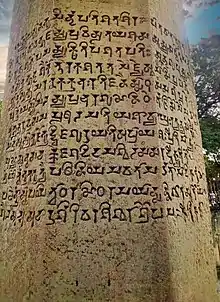
During Skandagupta's period, the Indo-Hephthalites (known as the White Huns or Hunas) invaded India from the northwest, advancing as far as the Indus River.[13]
The Bhitari pillar inscription states that Skandagupta defeated the Hunas:[13]
(Skandagupta), "by whose two arms the earth was shaken, when he, the creator (of a disturbance like that) of a terrible whirlpool, joined in close conflict with the Hûnas; . . . . . . among enemies . . . . . . arrows . . . . . . . . . . . . proclaimed . . . . . . . . . . . . just as if it were the roaring of (the river) Ganga, making itself noticed in (their) ears."
The date of the Huna invasion is not certain. The Bhitari inscription mentions it after describing the conflict with the Pushyamitras (or the Yudhyamitras), which suggests that it happened later during Skandagupta's reign. However, a possible reference to this conflict in the Junagadh inscription suggests that it may have happened at the beginning of the Skandagupta's reign or during the reign of his father Kumaragupta. The Junagadh inscription, dated to the year 138 of the Gupta era (c. 457–458 CE) mentions Skandagupta's success against the mlechchhas (foreigners):[14]
...whose [Skandagupta's] fame, moreover, even [his] enemies, in the countries of the mlechchhas... having their pride broken down to the very root, announce with the words "verily the victory has been achieved by him."
— Junagadh inscription[13]
The victory against the mlechchhas happened in or before the year 136 of the Gupta era (c. 455-456 CE), when Skandagupta ascended the throne and when he appointed Parnadatta as the governor of the Saurashtra region, in which Junagadh is located. Since Skandagupta is not known to have fought against any other foreigners, these mlechchhas were probably the Hunas. If this identification is correct, it is possible that as a prince, Skandagupta was sent to check the Huna invasion at the frontier, and Kumaragupta died in the capital while this conflict was happening; Skandagupta returned to the capital and overcame rebels or rival claimants to ascend the throne.[14]
A sentence in the Sanskrit text Chandra-Vyakarana (c. 7th century) states Ajayad-Gupto Hunan, literally, "The Gupta conquered the Hunas". This may be a reference to Skandagupta's victory over the Hunas, although an alternative reading by scholar K. P. Jayaswal has "Jato" instead of "Gupto".[15] A story in the Kathasaritsagara (11th century) states that the legendary king Vikramaditya ascended the throne after his father Mahendraditya abdicated it, and inflicted a crushing defeat on the mlechchhas. Since Mahendraditya was a title of Kumaragupta, and Vikramaditya that of Skandagupta, this may be a reference to Skandagupta's victory over the Hunas.[16]
Western India
The Junagadh rock, which contains inscription of the earlier emperors, Ashoka and Rudradaman, has an inscription engraved on the orders of Skandagupta's governor Parnadatta. The inscription states that Skandagupta appointed governors of all provinces, including Parnadatta as the governor of Surashtra.[16] It is not clear if the verse refers to routine appointments made by the king, or his actions after a political turmoil resulting from a war of succession or invasion.[17] The inscription outlines several qualifications required to be the governor of Surashtra, stating that only Parnadatta met these requirements. Again, it is not clear if these were actual qualifications required to be a governor under Skandagupta's rule, or if the verse simply aims to eulogise Parnadatta.[16]
Parnadatta appointed his son Chakrapalita as the magistrate of the Girinagara city (near modern Junagadh-Girnar area), which was presumably the capital of Surashtra. The Junagadh inscription records Chakdrapalita's repairs to the Sudarshana lake, an ancient reservoir originally constructed by Chandragupta Maurya, and later improved by his grandson Ashoka. The dam was subsequently re-built by Rudradaman in c. 150, but burst in c. 456–457 (year 137 of the Gupta era). Chakrapalita is said to have spent an "immeasurable" amount of wealth to build an embankment, and is also credited with the construction of a Vishnu temple.[17]
An inscription of the Vakataka king Narendrasena claims that his commands were obeyed by the rulers of Kosala, Mekala and Malava. The regnal dates of Narendrasena are not certain, but he is generally thought to be a contemporary of Skandagupta. Since Malava was a part of the Gupta Empire at one time, it is possible that Narendrasena raided Gupta territories during Skandagupta's reign. Skandagupta would have restored Gupta control over the region soon after. A c. 460–461 inscription refers to the "tranquil reign of Skandagupta, the lord of hundred kings."[18]
Succession
The last known date of Skandagupta is c. 467–468 CE (year 148 of the Gupta era),[18] and he probably ruled for a few more years.[19]
Skandagupta was most probably succeeded by Purugupta, who appears to have been his half-brother. Purugupta was a son of Kumaragupta I from his chief queen, and therefore, must have been his legitimate successor. It is possible that he was a minor at the time of Kumaragupta I's death, because of which Skandagupta ascended the throne. Skandagupta appears to have died heirless, or his son may have been dethroned by Purugupta's family.[20]
Coinage
Compared to his predecessors, Skandagupta issued fewer gold coins, and some of these coins feature relatively less quantity of gold. It is possible that the various wars fought by him strained the state treasury, although this cannot be said with certainty.[5]
Skandagupta issued five types of gold coins: Archer type, King and queen type, Chhatra type, Lion-slayer type and Horseman type.[21] His silver coins are of four types: Garuda type, Bull type, Altar type and Madhyadesha type.[22] The initial gold coinage was on the old weight standard used by his father Kumaragupta of approximately 8.4 gm. This initial coinage is quite scarce. At some point in his reign, Skandagupta revalued his currency, switching from the old dinar standard to a new suvarna standard that weighed approximately 9.2 gm.[23] These later coins were all only of the Archer type, and this standard and type was followed by all subsequent Gupta rulers.
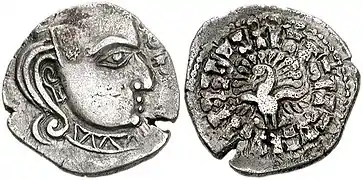 Coin of Skandagupta (455-467), in the style of the Western Satraps.[24]
Coin of Skandagupta (455-467), in the style of the Western Satraps.[24]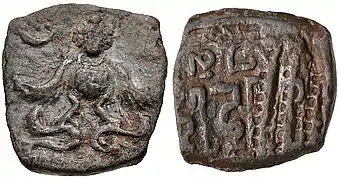 Coin of Skandagupta Kramaditya with facing Garuda.
Coin of Skandagupta Kramaditya with facing Garuda.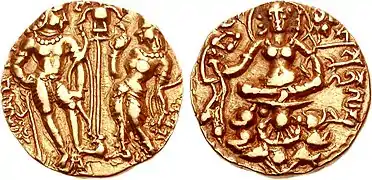 Gold dinar of Skandagupta.
Gold dinar of Skandagupta.
In popular culture
Jaishankar Prasad, a renowned poet of modern Hindi literature, wrote a play named Skandagupta in 1928, based on the life of Gupta emperor Skandagupta.[25] In the 1960s, Shanta Gandhi, Professor of Ancient Indian Drama while at National School of Drama, revived interest in Jaishankar Prasad's plays by successfully staging his most important play Skanda Gupta written in 1928, with little changes to the original script.[26][27]
The news article Dainik Jagran claimed that the popular movie Baahubali 2: The Conclusion was based on Skandagupta's life.[28]
References
| Gupta Empire 320 CE–550 CE | ||||||||||||||||||||||||||||||||||||
|---|---|---|---|---|---|---|---|---|---|---|---|---|---|---|---|---|---|---|---|---|---|---|---|---|---|---|---|---|---|---|---|---|---|---|---|---|
|
||||||||||||||||||||||||||||||||||||
- ↑ "For the temporary reprieve from the Huns won by Skandagupta was the final phase of Indian classicism . The king himself worshipped Hindu gods and goddesses, then returning to the fore, but he did not neglect other beliefs such as Jainism and Buddhism." in Cotterell, Arthur (30 June 2011). The Pimlico Dictionary Of Classical Civilizations. Random House. p. 367. ISBN 978-1-4464-6672-8. and Cotterell, Arthur (1998). From Aristotle to Zoroaster: An A to Z Companion to the Classical World. Free Press. p. 173. ISBN 978-0-684-85596-7.
- ↑ Allen, John (1914). Catalogue of the coins of the Gupta dynasties. p. 114.
- 1 2 3 4 5 R. C. Majumdar 1981, p. 69.
- ↑ Hermann Kulke & Dietmar Rothermund 2004, p. 96.
- 1 2 3 4 5 6 R. C. Majumdar 1981, p. 71.
- 1 2 R. C. Majumdar 1962, pp. 17–28.
- 1 2 Jagannath Agrawal 1968, p. 325.
- 1 2 Jagannath Agrawal 1968, p. 326.
- 1 2 3 4 R. C. Majumdar 1981, p. 70.
- ↑ "Junagadh Rock Inscription of Rudradaman", Project South Asia. Archived 23 February 2009 at the Wayback Machine
- 1 2 D. K. Ganguly 1987, p. 79.
- 1 2 R. C. Majumdar 1981, pp. 70–71.
- 1 2 3 R. C. Majumdar 1981, p. 73.
- 1 2 R. C. Majumdar 1981, pp. 73–74.
- ↑ R. C. Majumdar 1981, p. 74.
- 1 2 3 R. C. Majumdar 1981, p. 75.
- 1 2 R. C. Majumdar 1981, p. 76.
- 1 2 R. C. Majumdar 1981, p. 77.
- ↑ R. C. Majumdar 1981, p. 80.
- ↑ R. C. Majumdar 1981, p. 81.
- ↑ Sanjeev Kumar (2017). "Treasures of the Gupta Empire", Shivlee Trust, pp. 344–353.
- ↑ Ashvini Agrawal 1989, pp. 28–9, 31–2.
- ↑ A.S. Altekar (1957). "The Coinage of the Gupta Empire", Varanasi: Banaras Hindu University.
- ↑ "Evidence of the conquest of Saurastra during the reign of Chandragupta II is to be seen in his rare silver coins which are more directly imitated from those of the Western Satraps... they retain some traces of the old inscriptions in Greek characters, while on the reverse, they substitute the Gupta type ... for the chaitya with crescent and star." in Rapson "A catalogue of Indian coins in the British Museum. The Andhras etc.", p.cli
- ↑ "स्कंदगुप्त (नाटक) : जयशंकर प्रसाद". www.hindikahani.hindi-kavita.com.
- ↑ "Re-discovering Dhruvaswamini". The Hindu. 29 October 2009.
- ↑ Lal, Mohan (2006). The Encyclopaedia of Indian Literature – Volume 5. Sahitya Akademi. p. 4119. ISBN 81-260-1221-8.
- ↑ "स्कंदगुप्त की कहानी पर बनी है बाहुबली फिल्म". Dainik Jagran (in Hindi).
Bibliography
- Ashvini Agrawal (1989). Rise and Fall of the Imperial Guptas. Motilal Banarsidass. ISBN 978-81-208-0592-7.
- D. K. Ganguly (1987). The Imperial Guptas and Their Times. Abhinav. ISBN 978-81-7017-222-2.
- Hermann Kulke; Dietmar Rothermund (2004). A History of India. Psychology Press. ISBN 978-0-415-32919-4.
- Jagannath Agrawal (1968). "The status of Skandagupta's mother". Annals of the Bhandarkar Oriental Research Institute. 48–49: 325–327. JSTOR 41694254.
- R. C. Majumdar (1962). The History and Culture of the Indian People: The classical age. Bharatiya Vidya Bhavan.
- R. C. Majumdar (1981). A Comprehensive History of India. Vol. 3, Part I: A.D. 300–985. Indian History Congress / People's Publishing House. OCLC 34008529.
Further reading
- Singh, Jai Prakash (1976) History and Coinage of Skandagupta Kramāditya, Varanasi:Department of Ancient Indian History, Culture & Archaeology, Banaras Hindu University.

